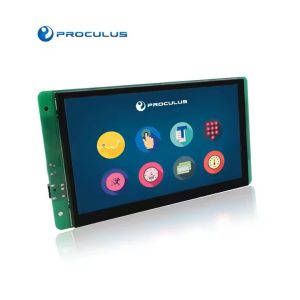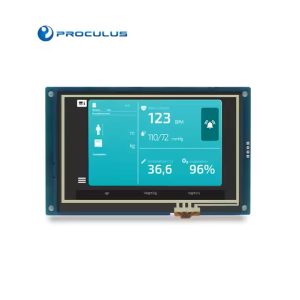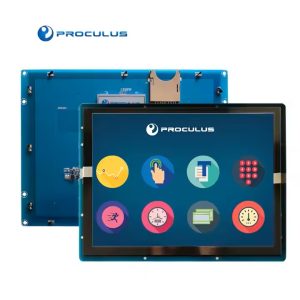Types of LCD display: what they are and how to choose
Different types of LCD displays technology are widely used in modern electronics, ranging from televisions and computer monitors to industrial displays and embedded systems.
LCD screens are known for their low power consumption, slim design, and high-quality image reproduction, making them an essential component in various applications.
When choosing an LCD display, it is crucial to understand the different types of LCD panels available and how their unique characteristics impact performance. Some of the key factors to consider include contrast ratio, viewing angles, response time, and color accuracy.
This guide provides an overview of the main LCD types, with a particular focus on Twisted Nematic (TN) LCDs and other advanced panel technologies. Keep reading!
 When selecting an LCD display, it is important to compare the different panel types based on their strengths and weaknesses.
When selecting an LCD display, it is important to compare the different panel types based on their strengths and weaknesses.
While TN panels are excellent for high-speed applications, IPS panels provide better color accuracy and wider viewing angles, making them ideal for professional use. VA panels, on the other hand, offer superior contrast ratios, making them well-suited for multimedia and television displays.
Note: According to different panel production areas, the delineation of A-level panels is also different. South Korea’s A-level boards require less than 3 dead pixels, Japan’s less than 5, and Taiwan requires less than 8.
What are the main types of LCD display?
LCD displays are classified based on their liquid crystal alignment and panel technology. Each type has distinct advantages and drawbacks, making them suitable for different use cases. Understand more about it bellow:1.VA soft screen
VA stands for Vertical alignment (vertical alignment) panel. It can provide 16.7M colors and large viewing angles. Of course, the price is also more expensive. It is currently the most commonly used soft screen panel for LCD TVs. The front side (front view) of the VA panel has the highest contrast, but the uniformity of the screen is not good enough, and color drift often occurs. Sharp text is its killer feature, and the performance of black and white contrast is also very good.2. IPS hard screen
IPS panel technology is a LCD panel TFT technology introduced by Hitachi in 1996, commonly known as “Super TFT”. It is currently the only hard-screen panel of TFT, and its application field has been very wide since its development. Products using IPS hard-screen generally have a higher positioning. The most prominent feature of this type of IPS board is that its two electrodes are on the same surface, while the electrodes of other liquid crystal modes are arranged on the upper and lower sides, three-dimensionally. Since the electrodes are on the same plane, the liquid crystal molecules are always parallel to the screen no matter what the state, which will reduce the aperture ratio and reduce the light transmittance.3. Twisted Nematic (TN) LCD
Twisted Nematic (TN) LCD is one of the oldest and most common LCD technologies. It is widely used in applications where fast response times and low production costs are prioritized, such as gaming monitors, budget-friendly displays, and simple digital interfaces. It operates by aligning liquid crystal molecules in a twisted formation between two glass substrates. When an electric current is applied, the molecules untwist, controlling the passage of light and generating the display’s images.Comparison of the main LCD types
 When selecting an LCD display, it is important to compare the different panel types based on their strengths and weaknesses.
When selecting an LCD display, it is important to compare the different panel types based on their strengths and weaknesses.
| Panel Type | Response Time | Viewing Angles | Color Accuracy | Contrast Ratio | Best Use Case |
| TN (Twisted Nematic) | Fast (1-5ms) | Narrow (160°/170°) | Low | Moderate | Gaming, budget monitors |
| IPS (In-Plane Switching) | Moderate (4-8ms) | Wide (178°/178°) | Excellent | Moderate | Professional design, high-end displays |
| VA (Vertical Alignment) | Moderate (5-10ms) | Decent (170°/178°) | Good | High | TVs, general-purpose monitors |
Discover other types of LCD display
In addition to the primary LCD types (TN, IPS, and VA), several other specialized LCD technologies have been developed to meet specific industry requirements. These include:- High Twisted Nematic (HTN): An improved version of TN technology that offers better contrast and viewing angles compared to standard TN panels. HTN is often used in calculator displays and small monochrome screens;
- Film Super Twisted Nematic (FSTN): An advanced STN (Super Twisted Nematic) display with an additional compensating film layer, which enhances contrast and readability. FSTN displays are frequently used in industrial instruments and automotive dashboards;
- Plane Line Switching (PLS): A panel technology developed by Samsung as an alternative to IPS, but with higher brightness and lower power consumption. PLS panels are found in high-end monitors and tablets;
- Super Twisted Nematic (STN): A variation of TN technology that provides better contrast and lower power consumption, making it common in portable and battery-powered devices. However, STN displays have slower response times and may exhibit color shifting;
- Thin-Film-Transistor (TFT) LCD: A widely used active-matrix LCD technology that employs thin-film transistors (TFTs) to enhance image quality. TFT LCDs are found in smartphones, tablets, laptops, and automotive displays;
- Passive and Active-Matrix Display: Passive-matrix LCDs are simpler and consume less power, but suffer from slower response times and lower image quality. Active-matrix LCDs, such as TFT LCDs, use transistor arrays to improve refresh rates and color performance;
- Advanced Fringe Field Switching (AFFS): A high-end variation of IPS technology designed for extreme viewing angles and superior color accuracy. AFFS panels are commonly used in medical imaging, avionics, and professional-grade applications.
The classification of LCD panel TFT
The liquid crystal panel TFT can be divided into three grades according to the quality of A, B and C. The difference is based on the number of dead pixels. However, there are no related hard and fast regulations in the world, so the grading standards of different countries and regions are not the same. Regardless of which standard is based, you must choose a professional and reliable LCD display manufacturers. The general situation is as follows:| Levels | Numbers of Dead Pixels |
| A++ | No |
| A+ | 1~3 |
| A | <5(Generally less than 5 are collectively referred to as A-level screens) |
| B | 6~10 |
| C | more than 11 |
Explore Proculus UART TFT LCD Modules
Proculus offers a range of UART TFT LCD modules designed to simplify display integration while providing high-quality visual output. Our solutions and services are tailored for embedded systems, industrial controls, medical devices, and smart products, ensuring optimal performance across various applications. Key features of Proculus UART TFT LCD modules include:- High-Resolution TFT Displays: Available in multiple sizes and resolutions to match different project requirements;
- Built-in GUI Development Software: Allows users to create intuitive, touch-based interfaces without deep coding expertise;
- Seamless Communication: The UART serial interface ensures stable and efficient data transfer with microcontrollers and processors;
- Customizable Solutions: Options for capacitive or resistive touchscreens, enhanced brightness, and ruggedized enclosures for demanding environments.
Conclusion
Choosing the right LCD display is crucial for achieving optimal performance in any project. Factors such as display type, power efficiency, viewing angles, durability, and interface compatibility should be carefully considered to ensure the best fit. UART TFT LCD modules offer a compelling advantage by simplifying system design, reducing development time, and improving graphical capabilities for projects requiring an easy-to-integrate, high-performance display solution. Whether for industrial applications, medical devices, or consumer electronics, investing in the right LCD technology will enhance user experience and overall project success. Ready to take the next step? Start prototyping smarter with the Proculus P.BOX Starter Kit — everything you need to accelerate development in one complete package.
Category:
Author:
Client:
Date:
PHP Code Snippets Powered By : XYZScripts.com
 English
English


